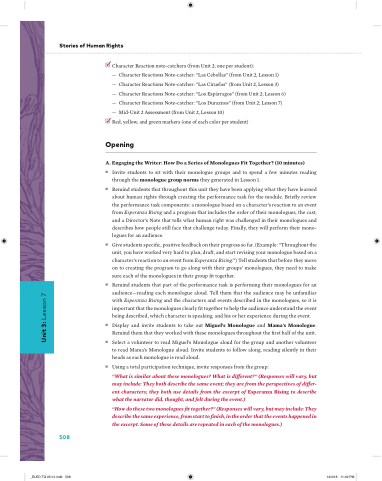Page 532 - EL Grade 5 Teacher Guide
P. 532
Stories of Human Rights
✓ Character Reaction note-catchers (from Unit 2; one per student):
— CharacterReactionsNote-catcher:“LasCebollas”(fromUnit2,Lesson1)
— CharacterReactionsNote-catcher:“LasCiruelas”(fromUnit2,Lesson3)
— CharacterReactionsNote-catcher:“LosEspárragos”(fromUnit2;Lesson6) — CharacterReactionsNote-catcher:“LosDuraznos”(fromUnit2;Lesson7) — Mid-Unit2Assessment(fromUnit2,Lesson10)
✓ Red, yellow, and green markers (one of each color per student) Opening
A. Engaging the Writer: How Do a Series of Monologues Fit Together? (10 minutes)
■
■
■
■
■
■
■
Invite students to sit with their monologue groups and to spend a few minutes reading through the monologue group norms they generated in Lesson 1.
Remind students that throughout this unit they have been applying what they have learned about human rights through creating the performance task for the module. Brie y review the performance task components: a monologue based on a character’s reaction to an event from Esperanza Rising and a program that includes the order of their monologues, the cast, and a Director’s Note that tells what human right was challenged in their monologues and describes how people still face that challenge today. Finally, they will perform their mono- logues for an audience.
Give students speci c, positive feedback on their progress so far. (Example: “Throughout the unit, you have worked very hard to plan, draft, and start revising your monologue based on a character’s reaction to an event from Esperanza Rising.”) Tell students that before they move on to creating the program to go along with their groups’ monologues, they need to make sure each of the monologues in their group t together.
Remind students that part of the performance task is performing their monologues for an audience—reading each monologue aloud. Tell them that the audience may be unfamiliar with Esperanza Rising and the characters and events described in the monologues, so it is important that the monologues clearly t together to help the audience understand the event being described, which character is speaking, and his or her experience during the event.
Display and invite students to take out Miguel’s Monologue and Mama’s Monologue. Remind them that they worked with these monologues throughout the rst half of the unit.
Select a volunteer to read Miguel’s Monologue aloud for the group and another volunteer to read Mama’s Monologue aloud. Invite students to follow along, reading silently in their heads as each monologue is read aloud.
Using a total participation technique, invite responses from the group:
“What is similar about these monologues? What is di erent?” (Responses will vary, but may include: They both describe the same event; they are from the perspectives of di er- ent characters; they both use details from the excerpt of Esperanza Rising to describe what the narrator did, thought, and felt during the event.)
“How do these two monologues t together?” (Responses will vary, but may include: They describe the same experience, from start to nish, in the order that the events happened in the excerpt. Some of these details are repeated in each of the monologues.)
508
_ELED.TG.05.01.indb 508
12/4/18 11:49 PM
Unit 3: Lesson 7


